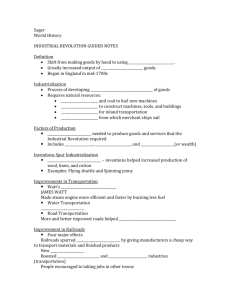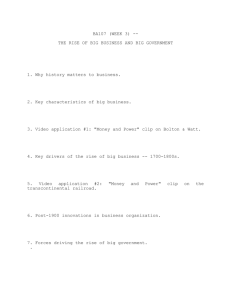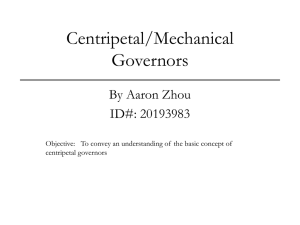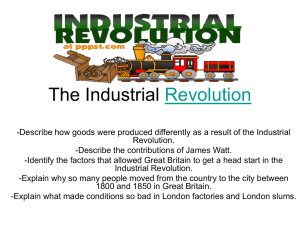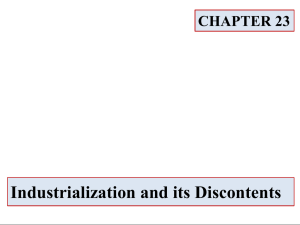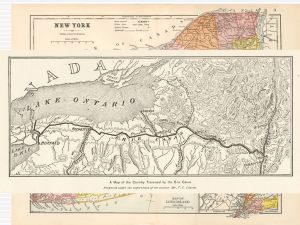World History 9
advertisement
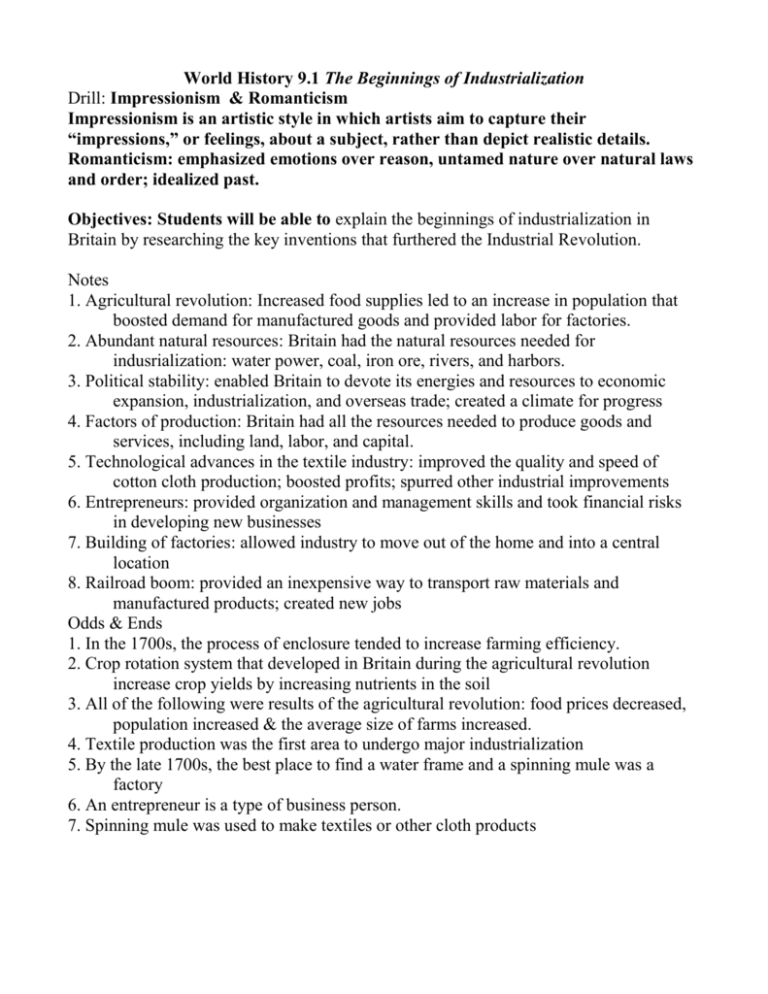
World History 9.1 The Beginnings of Industrialization Drill: Impressionism & Romanticism Impressionism is an artistic style in which artists aim to capture their “impressions,” or feelings, about a subject, rather than depict realistic details. Romanticism: emphasized emotions over reason, untamed nature over natural laws and order; idealized past. Objectives: Students will be able to explain the beginnings of industrialization in Britain by researching the key inventions that furthered the Industrial Revolution. Notes 1. Agricultural revolution: Increased food supplies led to an increase in population that boosted demand for manufactured goods and provided labor for factories. 2. Abundant natural resources: Britain had the natural resources needed for indusrialization: water power, coal, iron ore, rivers, and harbors. 3. Political stability: enabled Britain to devote its energies and resources to economic expansion, industrialization, and overseas trade; created a climate for progress 4. Factors of production: Britain had all the resources needed to produce goods and services, including land, labor, and capital. 5. Technological advances in the textile industry: improved the quality and speed of cotton cloth production; boosted profits; spurred other industrial improvements 6. Entrepreneurs: provided organization and management skills and took financial risks in developing new businesses 7. Building of factories: allowed industry to move out of the home and into a central location 8. Railroad boom: provided an inexpensive way to transport raw materials and manufactured products; created new jobs Odds & Ends 1. In the 1700s, the process of enclosure tended to increase farming efficiency. 2. Crop rotation system that developed in Britain during the agricultural revolution increase crop yields by increasing nutrients in the soil 3. All of the following were results of the agricultural revolution: food prices decreased, population increased & the average size of farms increased. 4. Textile production was the first area to undergo major industrialization 5. By the late 1700s, the best place to find a water frame and a spinning mule was a factory 6. An entrepreneur is a type of business person. 7. Spinning mule was used to make textiles or other cloth products World History 9.1 The Beginnings of Industrialization Answer Key 1. a 2. b 3. c 4. d 5. b 6. c BCR1. Modern agricultural techniques, Abundant food supplies, Increasing population, High demand for food and goods, Large population of workers, Extensive natural resources, Expanding economy, Highly developed banking system, Encouraging business climate for investors, Availability of bank loans, Increasing overseas trade, Economic prosperity, Climate of progress, Political stability, & Positive attitude BCR2 Enclosures were large fields that were fenced off and on which landowners experimented to discover more productive farming methods to boost crop yields. Crop rotation was the system of growing different crops in the same field on succeeding years to preserve the fertility of the soil. Both greatly increased crop yields and led to an agricultural revolution. HISTORYMAKERS James Watt 1. Before the steam engine, work was limited to the power that could be generated by muscles or wind. The steam engine could drive machines to do more and heavier work. 2. A patent gives an inventor the right to enjoy the rewards of his or her invention by requiring others who use it to pay a fee. It does not last forever; Watt’s patents expired in 1800. 3. Watt was an inventive genius while Boulton had business sense. Boulton foresaw the need for the rotary steam engine, for instance, but Watt was needed to make the invention. Summary: In today’s lesson we discussed the beginnings of industrialization in Britain by researching the key inventions that furthered the Industrial Revolution. Homework: Textile Industry & Entrepreneurs Textile Industry: produced cotton and other cloth products Entrepreneurs: provided organization and management skills and took financial risks in developing new businesses Name _______________________________________________Period_____________ World History 9.1 The Beginnings of Industrialization Terms and Names Write the letter of the best answer. ______ 1. In the 1700s, the process of enclosure tended to increase a. farming efficiency. b. farmers’ reliance on a single cash crop. c. the use of the broadcast method of seeding. d. the amount of common land available for grazing. ______ 2. How did the crop rotation system that developed in Britain during the agricultural revolution increase crop yields? a. by allowing more land to rest b. by increasing nutrients in the soil c. by ensuring that more of the seeds that were planted actually sprouted d. by decreasing the amount of land used to grow nutrient-depleting crops ______ 3. All of the following were results of the agricultural revolution in Britain EXCEPT that a. food prices decreased. b. population increased. c. the number of farmers increased. d. the average size of farms increased. ______ 4. Which of the following was the first area to undergo major industrialization? a. banking c. coal mining b. railroads d. textile production ______ 5. By the late 1700s, the best place to find a water frame and a spinning mule was in a. a barn. c. a farm house. b. a factory. d. an urban home. ______ 6. An entrepreneur is a type of a. scientist. c. business person. b. inventor. d. personal secretary. BCR1. Critical Thinking Briefly answer the following, identify some of the factors of production present in Britain that encouraged the Industrial Revolution. BCR2. Using Context Clues define enclosure and crop rotation and explain how both paved the way for an agricultural revolution. HISTORYMAKERS James Watt Powering the World “A New Invented Method of Lessening the Consumption of Steam and Fuel in Fire Engines.”—title on the patent application for James Watt’s first invention (1769) For centuries, human and animal muscle pulled plows and wagons and operated oars. In addition, wind provided the power to run windmills and propel ships. However, these methods put limits on the amount of work that could be done. In 1705, the development of the steam engine broke through these barriers, and in 1765 a Scotsman named James Watt further spurred industrialization by vastly improving the steam engine. Watt was born in Scotland in 1736. He was a sickly child, and his mother schooled him at home for a few years. However, the largest part of his education was in his father’s workshop. He was a shipbuilder who also made devices for navigation. Young James was given his own tools, bench, and forge, and he learned how to build machines by making models of cranes and organs. At age 18, Watt decided to become a maker of mathematical instruments. After some training, he moved to Glasgow to begin his work. Local guilds—organizations of craft workers—prevented him from starting his own business. Some friends, however, secured him an appointment at the University of Glasgow to practice his craft. Before Watt was 30 years old, he had developed his first invention. He was asked to fix a steam engine used for demonstrations in a physics class. Steam engines had been in use for many decades in the mining industry, where they pumped water out of deep shafts. The problem was that these machines burned a tremendous amount of fuel to make steam. As Watt repaired the engine, he noticed this inefficiency. The steam produced by the engine was pushed into a cylinder where the steam then cooled. The problem was that the cylinder had to be heated again because it cooled along with the steam. Watt invented a separate chamber where the steam could be condensed without reducing the temperature of the cylinder. As a result, his improved steam engines used considerably less fuel. Watt then became partners with a business owner so he could manufacture his machine. Watt also filed a patent to own the rights to his creation. Others could use it, but they had to pay a fee to Watt. In a few years his first partner was replaced by another, Matthew Boulton. Watt and Boulton worked together for several decades. They were a good team, with Watt providing the engineering knowledge and Boulton the business sense. Watt continued to find new ways to make the steam engine work better. Then Boulton convinced Watt to devise one major improvement. Boulton believed that the steam engine could be used in mills that made flour and textiles. To be useful, though, the engine would have to drive machines that moved in a circle, not up and down like a pump. By 1781, Watt had built a motor that rotated a shaft that came out of the machine. As Boulton had predicted, the new invention caught on quickly. By 1800, his and Watt’s company had sold about 500 steam engines in Great Britain, and most were the new rotating type. Watt was also interested in chemistry and won credit for an important discovery. He was the first to suggest that water was not a basic element but a compound made of different chemicals. However, the was never able to identify what was involved in making water. Watt was responsible for other inventions and held many different patents. They earned him around 76,000 British pounds in just over a decade. In 1800, when the patents expired, he and Boulton gave their business to their sons and retired. Watt lived 19 more years, spending the time traveling and receiving honors for his work. However, his interest in machines did not end. He had a workshop made in the attic of his house, where he continued to tinker. Questions 1. Drawing Conclusions Why was the steam engine an improvement in powering work? 2. Using Context Clues What is a patent? Does the right it grants last forever? 3. Making Judgments How did Watt’s and Boulton’s different abilities strengthen their partnership? Summarize today’s lesson. CHAPTER 9 CHAPTER 9
